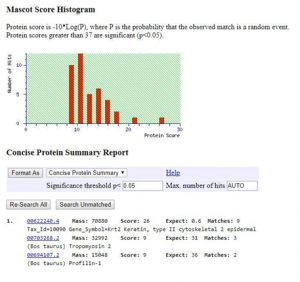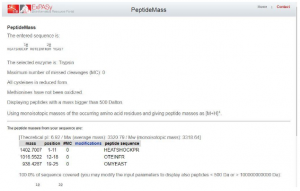Bioinformatics PROTEOMICS REPORT Case Study Solution
Question 02:
Value: 30%
Question 03:
Mass: 70880 m/z
Question 04:
Option A is correct.
Part B
Question 05:
| Protein in response to Caspofungin | |
| CaGAP1 Glyceraldehyde-3-phosphate dehydrogenase|Candida al bi cans | 44.78% |
| CaSSA 4 cahsp 70 mRNA for heat shock|Candida al bi cans | 37.04% |
| CaACF 3 end o-1,3-beta-glucanase|Candida al bi cans | 10.47% |
| CaTEF 1 translation elongation factor eEF 1 alpha-A chain|Candida al bi cans | 24.67% |
| CaSS A1 Heat shock protein of HSP 70 family|Candida al bi cans | 24.34% |
| putative cell wall protein of the PIR family|Candida al bi cans - [CA 3030 | 25.14% |
Question 06:
Referring to the excel sheets being provided, the excel table shows #DIV/0! Error in the fold change column because in the cell the term is divided by 0, or cell has 0 value or it is blank, the term representing the changes in quantity going to a final value. In addition to this, it depicts that there is no fold decrease in the excel column.
Question 07:
More strikingly, by relating the amino acids that has been identified to the gene function regulation. Functional protein category in the same condition have been characterized by the codon usage pattern and specific composition of amino acids. In addition to this, the proteins are tend to regulate the activity of organ or cell. Not only this, but it also transport material to the body parts.
Question 08:
Inevitably, Caspofungin most likely exerts prolonged effects against candida albi cans and c. furthermore, it also rapidly related with the target and exerting prolonged effects on 3-D-Glucan and β-1 enzyme complex. Despite of the specific mechanism, Caspofungin is most probably most active in comparison of the proliferating cells that would be consisting with the observation killed increased over the period of several hours. Caspofungin has been very effective in terms of treating the infection that has been caused by the candida species and aspergillus.
It has been demonstrated that Caspofungin at the above Mic concentration significantly reducing the eight candida burden isolates during the experiment of time-kill. In addition to this, the Caspofungin have been exhibiting the fungistatic and fungicidal activity on the basis of the test and isolate conditions. It has been also notified that the candida isolates have been killed by Caspofungin not exhibiting the elevated MIC that has indicated that the reason behind growth had not due to the preexisting resistant sub population and acquired resistance. Reasonably, it has been possible that the per sisters have replicated and dormant slowing the Caspofungin presence. If so, they would not tend to impaired irreversibly, as growth in liquid media after PAFE experiments and recovery from time-kill have not reduced.
Appendix
Appendix












